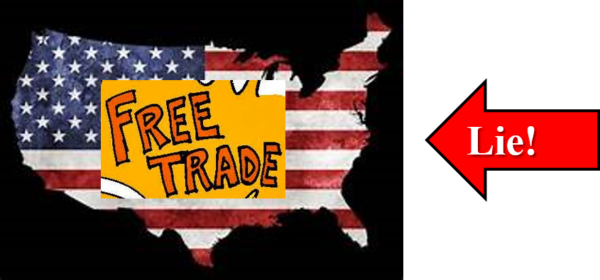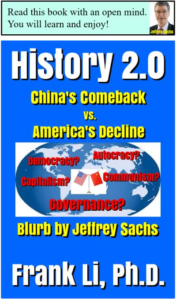The American version of “free trade” is a big, fat lie, just like American “free market” (American “free market” is a lie). It’s time to denounce it as such!
1. What is “free trade”?
Below is an excerpt from Wikipedia – free trade.
Free trade is a trade policy that does not restrict imports or exports. It can also be understood as the free market idea applied to international trade. In government, free trade is predominantly advocated by political parties that hold economic liberal positions, while economic nationalist and left-wing political parties generally support protectionism, the opposite of free trade.
Because “free trade” is simply an application of “free market” to international trade, if the latter is a lie (American “free market” is a lie), so is the former, right?
2. “Free trade” and America
Let’s divide the history of American “free trade” into five periods as follows:
- 1776–1863, concluded when slavery ended in America.
- 1864–2000, concluded when the rest of the world (vs. the West) started to come back.
- 2001–2016, concluded when Donald Trump became American President.
- 2017–2020, the Trump Presidency.
- 2021–Present, the Biden Presidency.
Let me elaborate on each …
2.1 1776–1863
After declaring independence from Britain in 1776, America continued the British policy of “free trade”. Two big examples:
- Slave trade.
- Stealth via “free trade”.
Let me briefly highlight each …
2.1.1 Slave trade
Slave trade was gravely exacerbated after America became independent, thanks to the huge desire for more “free labor” as a result of the surge in cotton (vs. tobacco) production!
2.1.2 Stealth via “free trade”
Below is an excerpt from a well-known book on American history (A People and A Nation – 8th Edition, pages 246-247):
Although Americans pride themselves on inventiveness and hard work, their start in industrial development depended on importing technology, sometimes by stealth. Greta Britain, which in the late eighteenth century had pioneered the invention of mechanical weaving and power looms, knew the value of its head start in the industrial revolution and prohibited the export of textile technology. But the British-born brothers Samuel and John Slater, their Scottish-born power-loom-builder William Gilmore, and Bostonians Francis Cabot Lowell and Nathan Appleton evaded British restrictions and patents to establish America’s first textile factories.
As an apprentice and then a supervisor in a British cotton-spinning factory, Samuel Slater had mastered the machinery and the process. Britain forbade the export of textile technology, so Slater emigrated to the United States disguised as a farmer. In 1790 in Pawtucket, Rhode Island, he opened the first water-powered spinning mill in America on the Blackstone River, rebuilding the complex machines from memory. With his brother John and their Rhode Island partners – Moses and Obadiah Brown and William Almy – Slater later built and oversaw mills in Rhode Island and Massachusetts. In 1815 he hired a recent immigrant, William Gilmore, to build a water-powered loom like those used in Britain. Later in the 1820s, the Slaters introduced British steam-powered looms. Spinning and weaving would now be done in New England factories organized along British models.
In 1810 Francis Cabot Lowell had the same idea as the Slaters: to build modern mills with mechanical, water-powered looms. Lowell took a family vacation to Britain, and in Edinburgh, Scotland, he met fellow Bostonian Nathan Appleton. Impressed by the textile mills they had seen in Britain, they laid plans to introduce water-powered mechanical weaving into the United States. They knew they had to acquire the “improved manufactures” from Britain that had made Manchester famous as a textile center. Lowell went to Manchester, during the day visiting and observing the factories, and meeting the factory managers. At night he returned to his hotel to sketch from memory the power looms and processes that he had seen. Back in the United States, he and others formed the Boston Associates, which created the Waltham-Lowell Mills based on Lowell’s industrial piracy. Within a few years, textile would be a major American industry, and the Boston Associates would dominate it.
Thus, the modern American industrial revolution began with international links, not home-grown American inventions. Ingenuity and industrial piracy put the United States on the road to industrial advancement.
2.2 1864–2000
Throughout this period, colonial America continued to thrive, in the name of “free market”, “free trade”, and democracy – all are big, fat lies.
2.3 2001–2016
Throughout this period, the rest of the world, led by China, came back, while the West (aka “[former] colonial powers”) declined. For example, America had trade deficits with more than 90 countries.
2.4 2017–2020
Upon becoming the President in 2017, Donald Trump started America’s retreat, starting with free trade. It was an honest recognition of the reality, but he did it in a wrong way – He launched various trade wars against many countries, especially China, Tonya Harding style, instead of pursuing political reforms at home, as I suggested!
What is the net result?
A total disaster for America!
Two informative readings:
- US trade deficit hits 14-year high, rises to 67.1 billion in August.
- Trump’s trade war on China was a failure in every possible way.
2.5 2021–Present
The Biden administration basically continued Trump’s trade war against China, whose effect has finally materialized in America: contributing hugely to the high inflation!
Two informative readings:
- Can high inflation in the US bring an end to the China-US trade war?
- Boeing Pain From US-China Trade War Seen in Airbus Bonanza.
3. Discussion
Just like “free market”, “Free trade” per se has been abused by the West – Both are colonial tricks invented by the British and continued by “colonial America” (Colonial America 1776-2030?)!
China, on the other hand, has the best practice of “free trade”. For more, read History 2.0 – China’s Comeback vs. America’s Decline.
4. Closing
American “free trade” is a big, fat lie!
Now, please sit back and enjoy the long video below – Milton Friedman was ridiculously wrong!



